Postscript for a Postscript
Our ANAT Emerging Writer Series continues with the finale in a series of five features by ANAT Arts Administrator and emerging writer Aushaf Widisto. Surveying SPECTRAvision, Aushaf reviews Episode 6: Postscript.
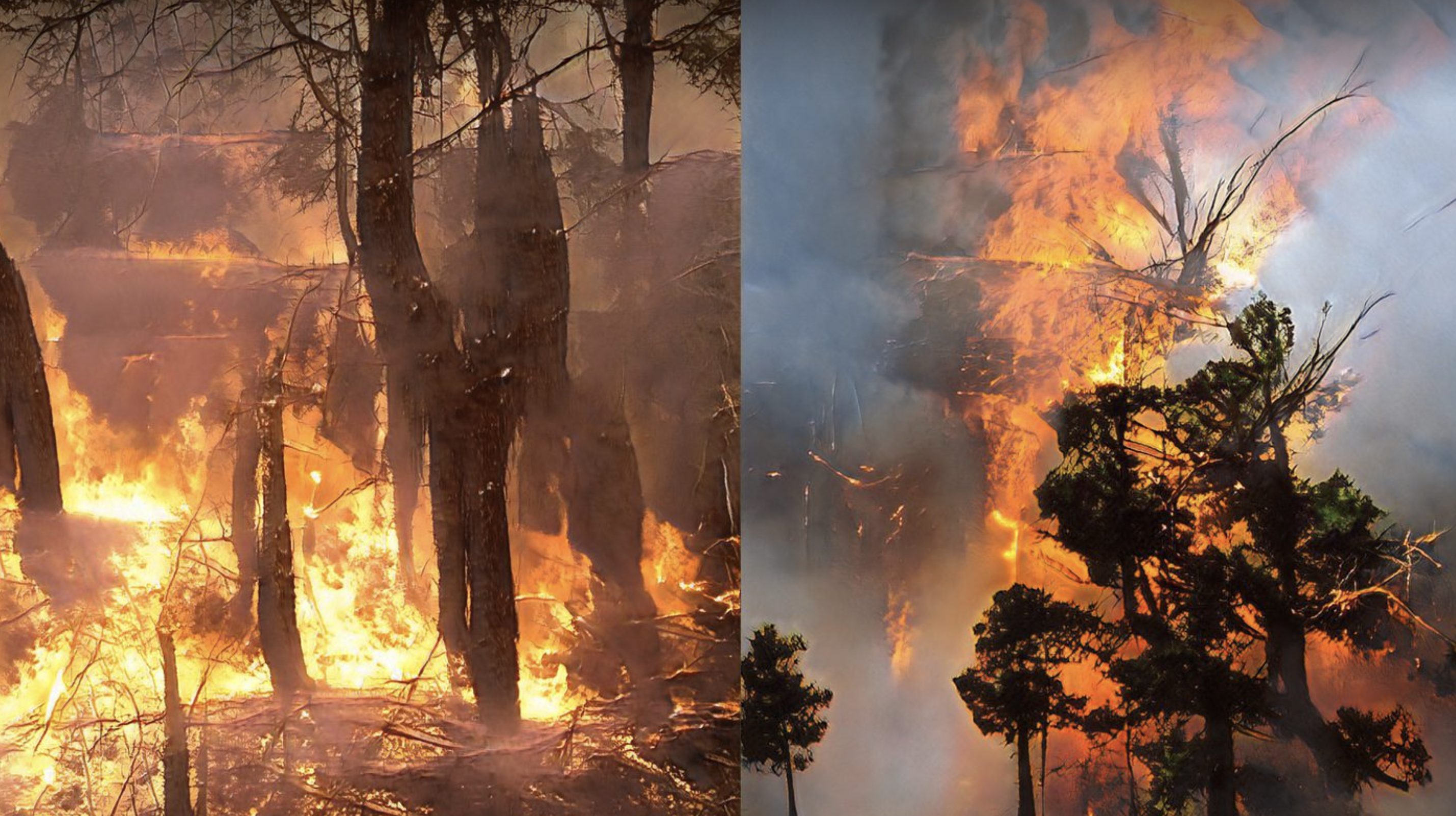
Deep Learning the Climate Emergency, 2022, Rebecca Najdowski.
SPECTRAvision Episode 6: Postscript
After three months of intense collaboration and exchange of ideas; Postscript closes the curtain on ANAT SPECTRA: Multiplicity 2022. This sixth and last episode of SPECTRAvision was organised as a series of moderated conversations and discussions, where participants were asked two simple questions: 1) what am I doing now? and 2) how will it affect what I do next?
These questions investigate how–through the intersection of art, science and technology–we could build a better, fairer, and more sustainable future. The presentations were structured into three sections: Data & Algorithms, Trans-Disciplinarity and Speculative Futures.
By picking one presentation from each section and writing what came to mind as I watch them, I’ve learned these three things from Postscript.
I. Data & Algorithms :: The Anthropocene Imperative
The word “Anthropocene” refers to a time period signified by the existence of humankind. And while it’s initially a neutral word, it’s often portrayed negatively when seen from a natural/environmental viewpoint. Dystopian and misanthropic narratives seem to be prevailing nowadays, with the climate crisis accelerating and the earth’s doomsday clock counting down closer and closer to zero.
To many people (e.g. climate activists), it seems “Anthropocene” is synonymous with “dark ages” or even “genocide” for many of the non-human inhabitants of planet earth. Harsh statements such as “mankind is to Earth what cancer cells are to the body” are strongly and ubiquitously expressed, referencing the uncontrolled multiplication of the human population. While one could surely understand the sentiment, is it wise to hold such a loathsome view of oneself and one’s own kind?
In her presentation, Seeing and Sensing Nature Through Machine Learning Art, Rebecca Najdowski explored how AI could help us get a more objective view. She asked: what might imagery generated through machine learning teach us about the Anthropocene?
To find answers, Rebecca looked at creative projects that contend with nature and proposes how artistic approaches to machine learning can offer more-than-representational modes of rendering nature. She quotes Kate Crawford in Atlas of AI, who noted that AI is neither artificial nor intelligent; rather, it’s both embodied and material–that is to say, it’s the product of natural resources, fuel, human labour, infrastructures, logistics, histories and classifications. This makes AI part of our day-to-day reality, and we can use it to reference biological processes to generate speculative images of nature.
An example of this is Anna Ridler’s Shell Record, where AI is used to capture how shells from the River Thames evolved throughout the Anthropocene. Artworks of this kind affirm the words of artist and researcher Joanna Zylinska, who proposed the “Anthropocene Imperative” as another meaning for AI. This alternative meaning captures AI’s potential to help us understand the longitudinal impact of human existence, and by extension, to find ways to reduce or even amend it.
Rebecca’s current project, Deep Learning the Climate Emergency, aims to do just that. It explores how AI could engage in perceiving and deep-learning environmental transformation throughout the Anthropocene, such as by having the technology analyse images of burning forests and cracking soils. The resulting AI-generated images exude an equally beautiful and disturbing quality, showing phenomena that are possible but not real–as if happening here and elsewhere simultaneously.
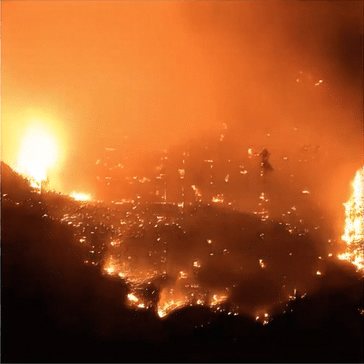
Deep Learning the Climate Emergency (draft), 2022, Rebecca Najdowski.
Citing Pasquinelli & Joler, Rebecca’s project made apparent the capacity of machine learning as knowledge magnification, a way to acquire knowledge lying beyond human reach. Using an AI image generator, we could extrapolate and visualise the impact of our existence without ever experiencing it.
Hopefully, after seeing how our choices shape the world, we’ll learn to make better ones.
II. Trans-Disciplinarity :: Excess Life Threatens Life Itself
And then there’s the idea of excess. In her presentation, Industries of Excess: A Transdisciplinary Exploration of Materiality in Contemporary Art, Hannah Hallam-Eames addressed the research and installation she completed for her MFA studies at Monash University. She covered how the installation was produced through the adoption of STEMM methodologies, and how the research methodology is transdisciplinary, transmogrifying themes within scientific, philosophical, and artistic disciplines.
Hannah began with Georges Bataille’s theory of excess, whose inquiry takes the superabundance of energy as the norm for organisms. An organism in Bataille’s general economy typically has an excess of energy available to it, unlike the rational actors of classical economy who are motivated by scarcity. This extra energy can 1) be used productively for the organism’s growth or 2) be lavishly expended. As we see all around us, the second option is highly prevalent. This excessive wasting of energy is commonly known as “luxury,” which Bataille dubbed “The Accursed Share” (also the title of his book).
Hannah applied Bataille’s theory of excess to two objects: algae bloom & crude oil, which are notably excessive materials due to their strong presence in the world as harmful expenditures from human intervention, contributing to both environmental and capitalist destruction:
- Algae blooms are fed by waste run-offs from industrial plants and agriculture (particularly surplus nitrogen and phosphorus), making it a form of excess to capitalist production. It contaminates food sources and drinking water and causes the demise of ecological lifeforms in fresh and saltwater bodies, known colloquially as “fish kills.”
- Crude oil is the liquid residue found in underground reservoirs extracted for producing materials such as petroleum, gas and plastics; which are horrifyingly present in the world’s ecosystems. The immense indestructibility of oil-based materials, with a lifecycle spanning far beyond anthropocentric interference with the earth, is a marker of excess in material form.
The primary creative outcome of this project was Industries of Excess, an installation that consists of four sculptural assemblages surrounded by the excess rubble of their own production.
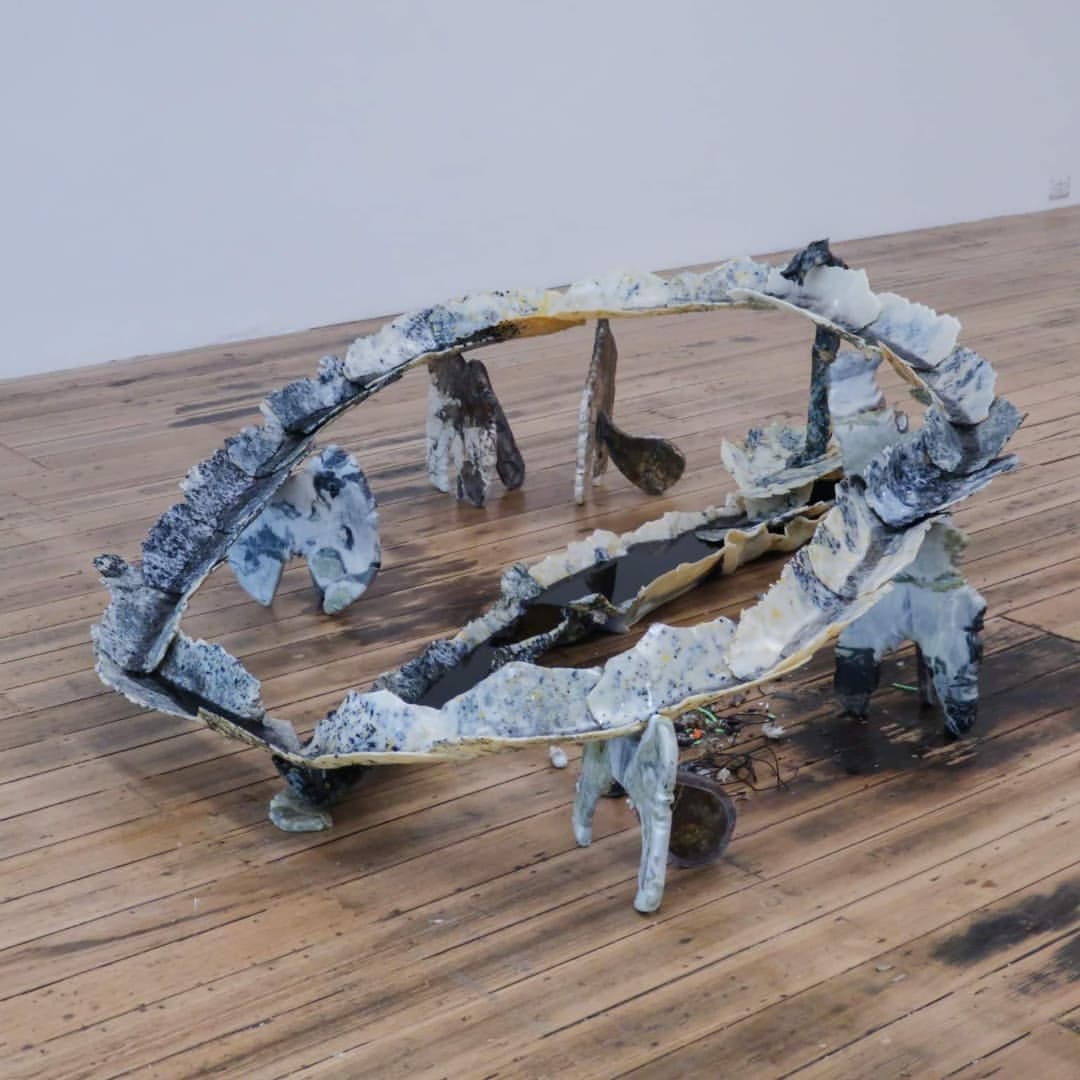
Travelling Valve (part of Industries of Excess), 2021, Hannah Hallam-Eames.
Hannah’s choice of research subjects explores how an excess of life poses a threat to life itself. Evidently, only decadence awaits when nature is put under the production of capitalist systems. This reminds me of the “mankind as cancer” notion, and how unbridled avarice always leads to a downfall.
Wu ji bi fan–“too much of a good thing is a bad thing.” Even growth itself is stifling when it’s unrestrained. Even power itself is corrupting when it’s left unchecked. And even life itself is deadly when there’s too much of it. Nothing excessive has ever been good. Virtue exists only in moderation.
III. Speculative Futures :: To Shed a Time-Light
Lastly, we have Deirdre Feeney and her presentation, Still mirror-mirror Time. In this thought-provoking session, Deirdre explained the working methodology of MirrorMirror, her 2020 ANAT Synapse Residency project, which she undertook in collaboration with quantum optical physicist Dr Geoff Campbell at the ANU Research School of Physics (RSP).
Through an intermingling of art, physics, nano-fabrication, ideas and mathematics; MirrorMirror develops a projected moving image system, aiming to bring about a renewed awareness of mediated perception and time. It demonstrates novel possibilities for creative applications of optics and enhances the viewer’s experience of witnessing the physical generation of a projected image.
The project started by investigating whether a projected moving image can be generated materially using a single image source and multiple mirror surfaces. It examines how changing focal lengths on various optically polished mirrored planes, embedded into an optical image system, can affect the transfer of light within the system and hence the projected image.
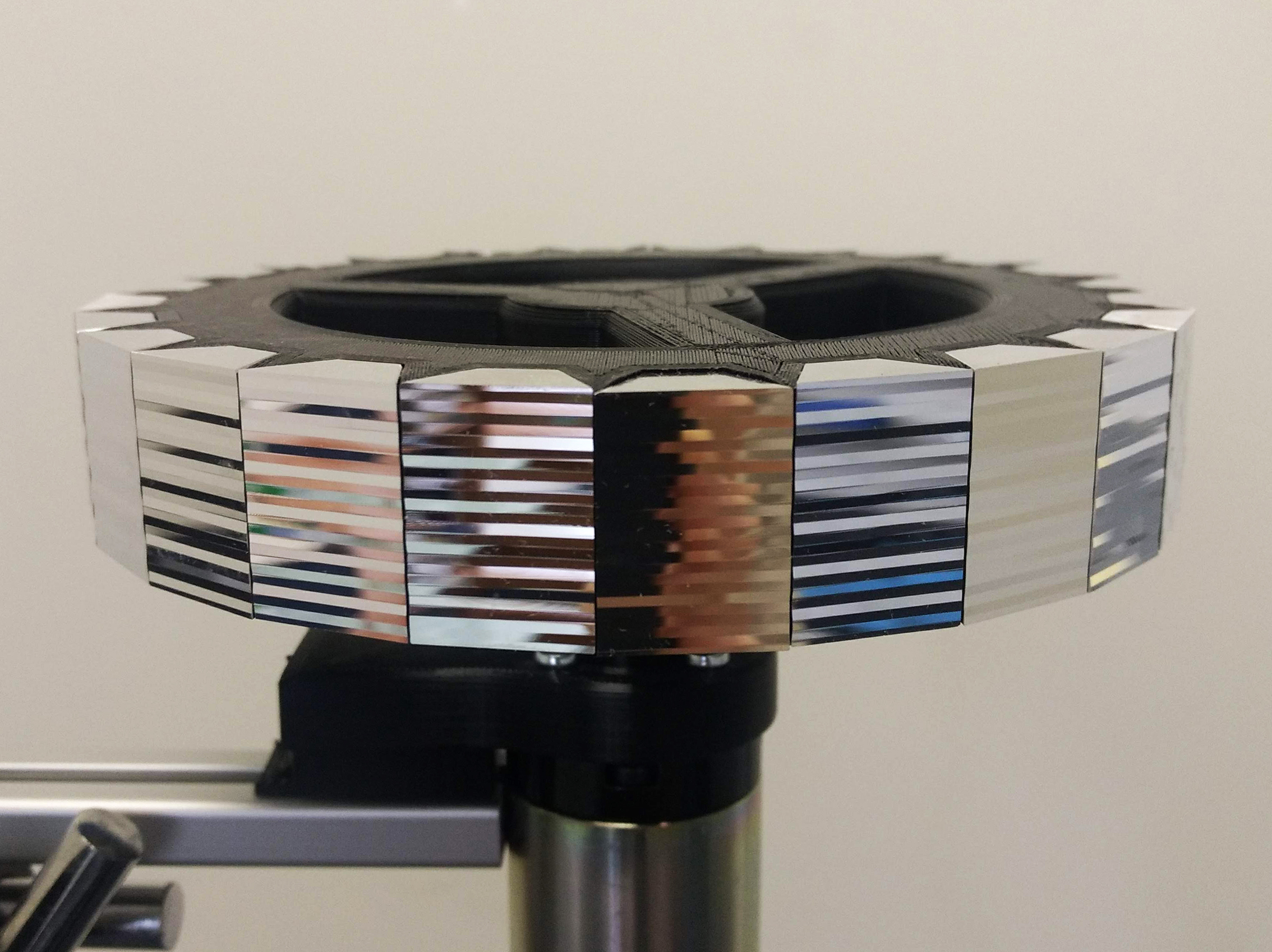
MirrorMirror, 2020, Deirdre Feeney.
This design was inspired by the 19th-century French inventor Charles-Émile Reynaud and his praxinoscope–an animation device that uses a strip of pictures placed around the inner surface of a spinning cylinder. The surfaces of the MirrorMirror device optically repattern light, via a pixel-cut pattern generated by code. This helps us to understand time differently, to distinguish between material and digital time and detach the concept of chronological from material time.
Deirdre also talks about the notion of “time-light,” expressing that by changing the light (through the materiality of glass), we can change our understanding of time. We can bring visibility to time by way of light, and loosen the grip of our conventional definition of time. In looking through the MirrorMirror device, we could perceive a parallel but different time than the one we’re experiencing. It’s like seeing an image of the world while simultaneously being in the world.
When various methods of understanding time are converged in artwork, we’ll see that time is both mediated and constructed. It’s not something that’s untouchable or transcendental. Perception is constantly mediated and thus shapes the experience of time.
But why do this, at all? Why go to such lengths to calibrate our perception and understanding of time? Deirdre noted that it’s to unshackle ourselves from our conventional, particularly Western notions of time so we can think differently about issues that matter. I think it enables us to ask ourselves: How much longer will we wait? Is our dilly-dallying justified? Do we have time, after all?
Now // Next
At some point in history, the arc of the Anthropocene started bending the wrong way. The ideas presented at Postscript made me think about how to bend that arc towards good, once more.
To start with, maybe we could try extrapolating the trajectory of our future, curbing our ways of excess, and shedding light on our view of time. Art is as effective a vessel for that as science and technology, and combining them all could only result in increased efficacy. Maybe, that’s how we save the world.
The things we’ve done, for better or worse, have led us to where we are now. And while we still have a choice, we must choose where to go next.
Can we alter our course in time, before we have to write a postscript?
ANAT would like to acknowledge our Curatorial Circle who walked alongside David Pledger: Alex Kelly, Nina Sellars, Tony Briggs, Robert Walton and Zena Cumpston, and our producing team, SPECTRAvision Producer, Dearna Newchurch, SPECTRAlive producer, Madeleine Collie, and producers Zamara Robison, Damienne Pradier (Typecast), Sophia Marinos and Robbie McEwan (The Things We Made Next).
ANAT SPECTRA 2022 was proudly presented by the Australian Network for Art and Technology (ANAT) in partnership with the Science Gallery Melbourne and Faculty of Fine Arts and Music, University of Melbourne and together with program partners The Things We Did Next (TTWDNext), Typecast Entertainment, RMIT University and Leonardo.
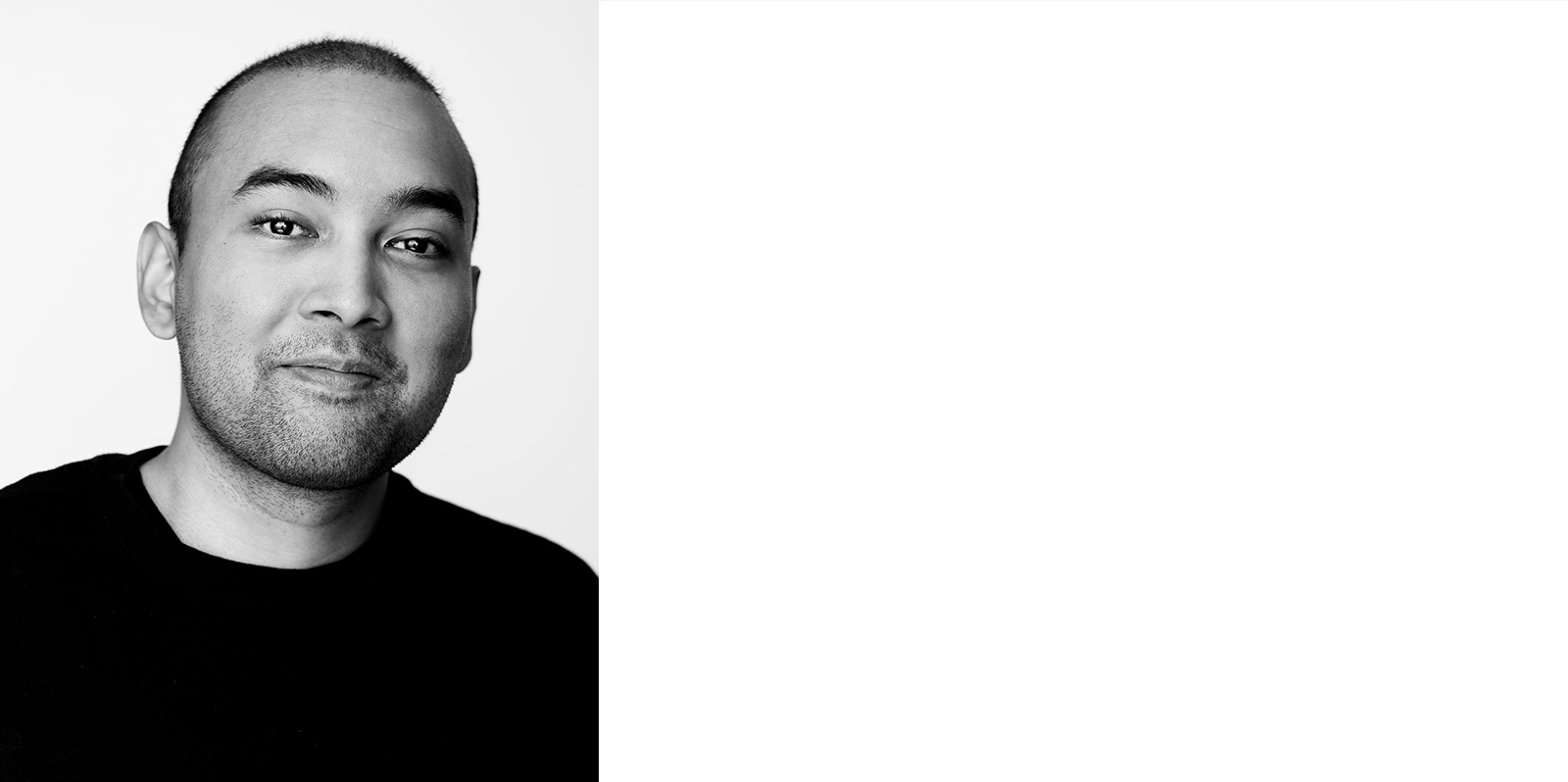
Aushaf Widisto, Emerging Writer and ANAT Arts Administrator
ANAT Arts Administrator Aushaf Widisto is an emerging writer and researcher from Indonesia. His writing has been featured in numerous publications across the web, both under his real name and pen name Adam Erland. After joining ANAT on an internship program, Aushaf begins his new part-time role as ANAT’s Arts Administrator in July 2022.
Having received a Bachelor of Urban & Regional Planning from Institut Teknologi Bandung and a Master of Cultural & Creative Industries from Monash University, Aushaf’s goal is to leverage arts and culture to create better cities and communities. Outside ANAT, he also works as a Research & Communications Assistant at Creative Economy. Previously, Aushaf worked with Asialink Arts.